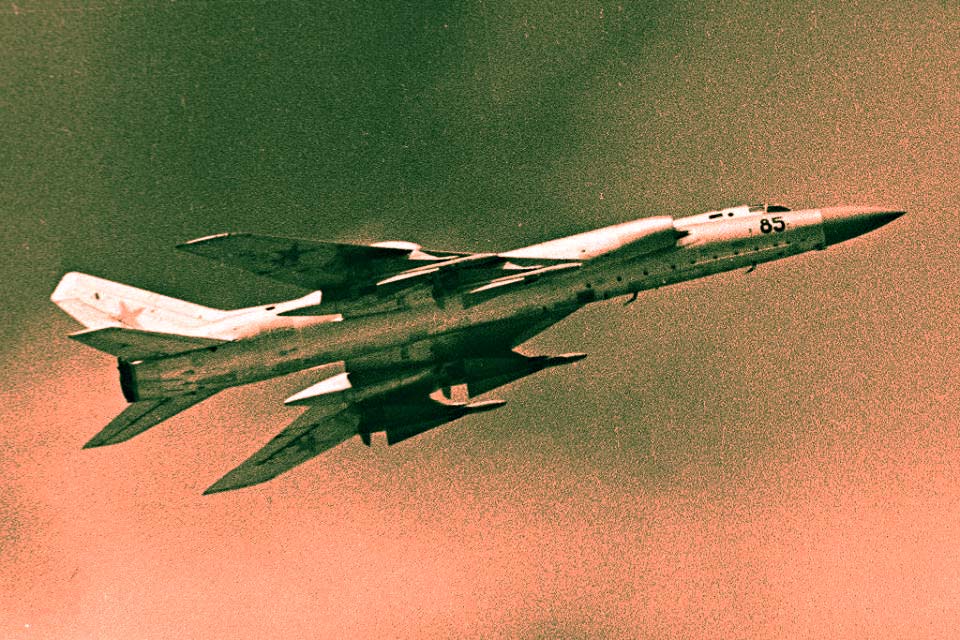The Tupolev Tu-28, known as “Fiddler” by NATO, is a long-range, high-speed Soviet interceptor, renowned as the largest and heaviest fighter ever built.
In Brief
The Tupolev Tu-28, NATO codenamed “Fiddler,” was a Soviet long-range interceptor introduced in the 1960s. It was designed to counter high-altitude threats, primarily strategic bombers. Featuring a massive radar system and armed with long-range air-to-air missiles, it remains one of the largest combat aircraft ever constructed. The Tu-28 was powered by two colossal turbojet engines, facilitating high-speed interception capabilities. Its size and powerful radar allowed for substantial armament, making it a formidable adversary. However, its vast dimensions and weight limited its maneuverability and operational flexibility, positioning it primarily as a strategic defense asset rather than a versatile fighter aircraft.
The Tupolev Tu-28, often recognized by its NATO reporting name “Fiddler,” stands as a monumental figure in the history of military aviation, particularly in the realm of interceptor aircraft.
History of the Development of the Tupolev Tu-28 (Fiddler)
In the late 1950s and early 1960s, the Soviet Union faced the strategic necessity of countering high-speed, high-altitude reconnaissance aircraft and bombers, primarily from the United States. The emergence of the U-2 and later the SR-71 Blackbird posed a significant threat, prompting the need for an effective long-range interceptor. The Tupolev Design Bureau, led by the renowned Andrei Tupolev, initiated the development of the Tu-28 to fulfill this role.
Launched in the context of escalating Cold War tensions, the program aimed to create an aircraft capable of reaching unprecedented altitudes and speeds to engage enemy bombers before they could release their payloads. The Tu-28 first took to the skies on March 18, 1961, demonstrating impressive performance that aligned with the Soviet Union’s strategic defense needs.
The NATO nickname “Fiddler” was attributed to this aircraft, following the tradition of assigning code names starting with ‘F’ to Soviet fighters. This name became synonymous with the Tu-28’s distinctive profile and its role in Cold War aviation history.
Design of the Tupolev Tu-28 (Fiddler)
The Tu-28’s design was a remarkable feat of engineering, tailored to meet the specific requirements of high-altitude, high-speed interception. It was constructed with a large and robust airframe, necessary to house the powerful radar system, substantial fuel reserves, and heavy armament, including long-range AA-5 ‘Ash’ missiles. The aircraft was powered by two Lyulka AL-7F-2 turbojet engines, which were among the most powerful engines of their time, contributing to the Tu-28’s impressive speed and altitude capabilities.
The interceptor featured a crew of two, including a pilot and a radar operator, seated in a pressurized cockpit, which was essential for the high-altitude missions it was designed to perform. The Tu-28’s radar, the ‘Big Nose’ Smerch radar, was one of the largest airborne radars fitted to a fighter aircraft, capable of detecting and tracking targets at considerable distances.
While the aircraft’s size endowed it with unparalleled range and payload capacity, it also resulted in a relatively low maneuverability, making it less effective in close combat situations. Moreover, the Tu-28’s operational complexity and maintenance requirements were significant, reflecting its advanced technology and the trade-offs required for its extraordinary performance.

Performance of the Tupolev Tu-28 (Fiddler)
The performance of the Tu-28 was extraordinary, with the aircraft capable of achieving speeds up to Mach 1.8 and operating at altitudes over 20,000 meters (65,600 feet). Its range was equally impressive, bolstered by its substantial fuel capacity, allowing it to patrol vast expanses of Soviet airspace and engage intruders far from Soviet borders.
Comparatively, the Tu-28 was unparalleled in its role as an interceptor, outperforming Western counterparts like the F-106 Delta Dart in terms of range and payload, albeit at the expense of agility and operational flexibility. Its capability to carry long-range missiles meant it could engage targets without entering enemy countermeasures envelopes, a significant strategic advantage during the Cold War.
Variants of the Tupolev Tu-28 (Fiddler)
The primary version of the Tu-28 was the Tu-128, which was the production variant of the initial Tu-28 design. Later, an upgraded variant known as the Tu-128M was developed, featuring enhanced avionics, improved engines, and upgraded weapons systems. Despite the limited number of variants, the Tu-128 remained a critical component of Soviet air defense throughout its service life.
Military Use and Combat of the Tupolev Tu-28 (Fiddler)
The Tu-28 was primarily deployed as a strategic interceptor within the Soviet Air Defense Forces. Its role was to engage high-altitude reconnaissance aircraft and bombers, a mission that gained critical importance with the advent of SR-71 Blackbird reconnaissance flights. While there are no known instances of the Tu-28 engaging in actual combat, its presence significantly contributed to the deterrence strategy of the Soviet Union, showcasing formidable capabilities that could potentially neutralize high-value aerial threats.
The operational history of the Tu-28 is marked by its strategic significance rather than its combat record, serving as a high-altitude guardian of Soviet airspace during a period marked by intense aerial reconnaissance and the ever-present threat of strategic bombing.
The Tupolev Tu-28 (Fiddler) remains a monumental figure in the annals of military aviation, embodying the pinnacle of Cold War-era interceptor design. Its development was a testament to the technological ambitions of the era, driven by the strategic imperatives of high-altitude, high-speed air defense. While it never saw combat, its sheer presence and the capabilities it represented played a crucial role in the strategic balance of the period, deterring potential high-altitude threats and safeguarding Soviet airspace with unmatched vigilance.
Back to the Fighter Jet section.